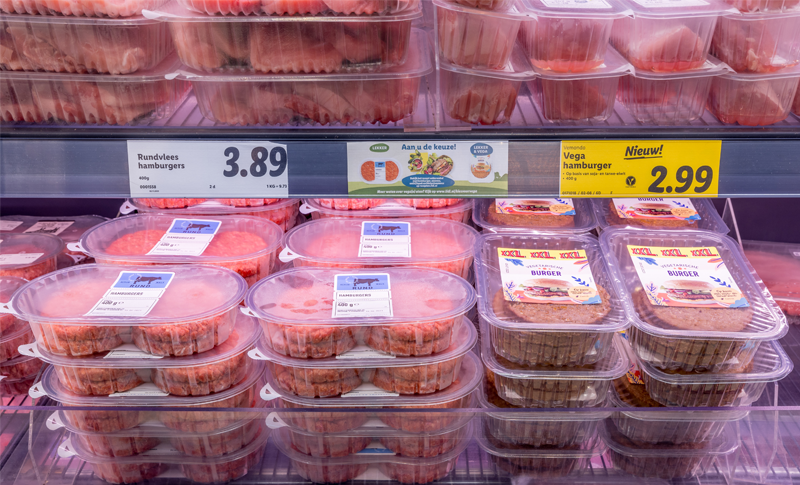The Lidl supermarket chain is running a pilot in which meat substitutes are placed on the shelf next to their ‘meat equivalent’. Some consumers are angry about this. Two WUR Social Sciences PhD candidates who are researching consumer responses to the protein transition comment on the commotion.
Earlier this month, Lidl started a trial in 70 branches in Noord-Holland and Almere in which they put four of their best-selling meat substitutes on display right next to the equivalent meat product. Lidl is working with WUR to see what effect this new shelf display setup has on purchases of meat products and meat substitutes. The supermarket chain is carrying out the test to introduce more consumers to vegetarian options and do its bit to help the protein transition.
But after they announced the pilot, they were inundated with negative comments. The supermarket was accused of duping consumers into buying the ‘wrong’ product and telling consumers what they should be eating. Monique van der Meer, a Marketing & Consumer Behaviour PhD candidate, is involved in the pilot.
Lidl doesn’t decide what I should eat
She thinks the negative reactions are premature. ‘The pilot has only just started and will run for three months. Only then will we be able to analyse the results. We’ll be able to see whether consumers are more likely to choose vegetarian options if they are displayed right next to the meat options.’
Meat is an emotive topic, says Yolie Michielsen, a PhD candidate in Consumption & Healthy Lifestyles. Michielsen studies the protein transition from a sociological perspective. ‘Other changes by Lidl to supermarket displays would never cause so much fuss and in most cases wouldn’t even get reported in the media.’
Freedom of choice
‘Supermarket assortments already have a big influence on the choices consumers make,’ says Van der Meer. This trial doesn’t change the product range; it only changes how the products are displayed. ‘The pilot is mainly aimed at consumers who aren’t yet considering meat substitutes. The supermarket is using the slogan “It’s your choice” to emphasize the fact that consumers do have a choice. It’s a kind of reminder.’
A lot of the comments have mentioned freedom of choice, says Michielsen. ‘Nowadays, a lot of people see the freedom to make your own choices as paramount, but less importance is attached to the implications of that choice. Initiatives to get people eating less meat are often approached in terms of choice and self-determination. People don’t appreciate top-down interventions.’
Van der Meer: ‘The pilot isn’t trying to mislead customers. The packaging is different and there are recipes on the shelf for the products where you can use either the meat substitute or the meat product.’ But is Lidl trying to tempt consumers? ‘Yes, to some extent. But mainly consumers who are already open to this option, such as flexitarians who visit the meat section through force of habit. We hope to make the choice easier for them.’
‘People are becoming more hostile to the government and public authorities,’ says Michielsen. ‘You see that in these reactions. For example, it was suggested the pilot is aiming to dupe consumers into buying meat substitutes instead of meat.
People with strong convictions often make more of a fuss
That suggestion may be based on a general idea that elites act in their own interests rather than the interests of “ordinary people”.’
Some consumers seem to be afraid they will choose the wrong product due to the new display setup. ‘But the meat substitutes have very different packaging to their meat equivalent, so there is not much chance of consumers getting them confused,’ says Van der Meer. ‘The main reason to make meat substitutes look like meat is to make them feel familiar to consumers in terms of their appearance and taste and how to cook them. That may make it easier for consumers to switch to vegetarian alternatives.’
Michielsen: ‘The negative comments show that people find eating meat normal and appropriate, and they see the meat substitutes as “wrong”. While consumers still have a choice, pilots like this do raise the question of what it means for the future of meat. Consumers might be wondering if the meat substitutes are going to take over the meat section, or whether there’ll soon be no more meat at all on the shelves. That can cause resistance.’
Making a fuss
Michielsen says this issue, of whether or not to eat meat, is not an isolated instance. ‘Other habits and traditions are also gradually shifting, in part due to policies. Examples are the Saint Nicholas celebrations and fireworks on New Year’s Eve. Some groups in society feel misunderstood by policymakers and think people high up are undermining traditions they set great store by. Placing meat substitutes next to the meat is seen as another sign of a cherished tradition under threat.’
‘But the fierce reactions aren’t necessarily representative of how everyone feels about it,’ Michielsen points out. Van der Meer agrees: ‘People with strong convictions often make more of a fuss. Especially on social media, people often vent their general frustration more or less at random on whatever topic turns up. What is more, these extreme reactions only come from a small proportion of the Dutch population.’
Michielsen: ‘Being flexitarian is increasingly popular. And while there is no scientific proof as yet, there are signs that most Dutch people agree that policy instruments should be used to reduce meat consumption.’

 The meat substitute is displayed next to the equivalent meat product. Above them is a recipe that can be prepared with either the meat or its substitute. ‘The supermarket wants to emphasize that people do have a choice, as a kind of reminder.’ Photo Lidl
The meat substitute is displayed next to the equivalent meat product. Above them is a recipe that can be prepared with either the meat or its substitute. ‘The supermarket wants to emphasize that people do have a choice, as a kind of reminder.’ Photo Lidl 

